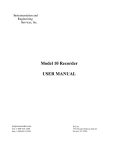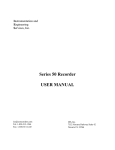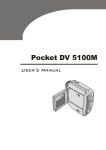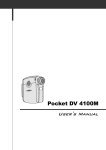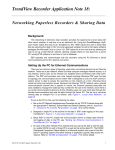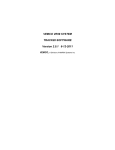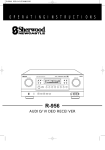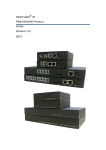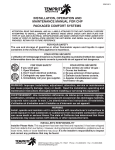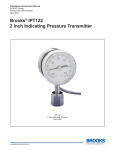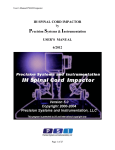Download VFR 1 Recorder USER MANUAL
Transcript
Instrumentation and Engineering Services, Inc. VFR 1 Recorder USER MANUAL [email protected] Tel: 1-850-515-1244 Fax: 1-850-515-1245 Tel. 850-244-2128 Fax 850-244-7979 IES, Inc. 7552 Navarre Parkway Suite 42 Navarre FL 32566 151 Mary Esther Blvd., Suite 311 Mary Esther, FL 32569 VFR 1............................................................................................................................... 1 Overview...................................................................................................................... 1 Specifications............................................................................................................... 1 Electrical .................................................................................................................. 1 Power ....................................................................................................................... 2 Physical .................................................................................................................... 2 Operational Theory ...................................................................................................... 2 Control Logic ........................................................................................................... 2 Analog-to-Digital (A/D) Converter ......................................................................... 3 Memory.................................................................................................................... 3 Micro-controller....................................................................................................... 3 Oscillator Speed ....................................................................................................... 4 Amplifier Gains ....................................................................................................... 4 Amplifier Bias.......................................................................................................... 4 Triggering Modes..................................................................................................... 4 Recorder Operational Modes ....................................................................................... 5 Sleeping.................................................................................................................... 5 Standby .................................................................................................................... 5 Recording................................................................................................................. 5 Awaiting T1 ............................................................................................................. 5 Data Downloading ................................................................................................... 5 Interface Signals Location and Description............................................................. 5 Operational Software ....................................................................................................... 9 VFR Software Program – Main Menu......................................................................... 9 Page 1 of the Main Menu......................................................................................... 9 Page 2 of the Main Menu....................................................................................... 20 Page 3 of the Main Menu....................................................................................... 31 VFR Software Program – Display Data..................................................................... 35 Encapsulation................................................................................................................. 47 Epoxy-Casting............................................................................................................ 47 Compound Formulation ......................................................................................... 47 Mold Preparation ................................................................................................... 47 Container Preparation ............................................................................................ 47 Compound Preparation .......................................................................................... 48 Compound De-aeration.......................................................................................... 48 Compound Application.......................................................................................... 48 Compound Cure ..................................................................................................... 48 Recorder Packaging ................................................................................................... 49 Epoxy Encapsulation ............................................................................................. 49 Glass Bead Encapsulation...................................................................................... 49 Paraffin Encapsulation ........................................................................................... 49 Appendix A.................................................................................................................... 51 Example VFR Settings............................................................................................... 51 Appendix B .................................................................................................................... 56 VFR 1 Signal Locations............................................................................................. 56 VFR 1 Overview The VFR1 is a reusable, compact, high shock, solid-state, recorder designed to acquire data in hostile test environments. The epoxy-encapsulated unit was designed to fit inside of a general-purpose bomb fuze booster cup. By installing the recorder in the place of the fuze booster and lead, the user is able to record the impact acceleration event as well as several analog and eight digital events. The VFR1 can be programmed for various trigger modes, filter frequencies, sample rates, amplifier gain, and amplifier bias. All of the programmable features are available to the user through a menu-driven computer operating system (operating in a Windows environment). On-line computer aided assistance is available to the user when setting-up the amplifier gain and bias. The user has a visual display of the recorder range and zero settings rather than relying on calculations. Low power consumption allows the test instrumentation to be built weeks before the test and extends the time for data retrieval. After a test, the recorder data is retrieved using a personal computer and the same computer operating system that is used to program the recorder. Specifications Electrical Number of Programmable Analog Channels.......................................................................1 Number of Buffered Analog Channels ................................................................................2 Number of Digital Channels ................................................................................................8 Analog Channel Sample Rate (High Speed)...........................................................57.8 kHz Analog Channel Sample Rate (Low Speed 0) ........................................................28.9 kHz Analog Channel Sample Rate (Low Speed 1) ..........................................................7.2 kHz Analog Channel Sample Rate (Low Speed 2) ..........................................................1.8 kHz Analog Channel Sample Rate (Low Speed 3) ...........................................................451 Hz Analog Channel Sample Rate (Low Speed 4) ...........................................................112 Hz Analog Channel Sample Rate (Low Speed 5) .............................................................28 Hz Analog Channel Sample Rate (Low Speed 6) ...............................................................7 Hz Analog Channel Sample Rate (Low Speed 7) ............................................................1.8 Hz Analog Channel Signal Bandwidth......................................... Selectable 2.3kHz or 9.3kHz Analog Channel Amplitude Resolution ..................................................... 256 digital steps Analog Channel (Programmable) .......................................... Filter8-pole elliptic low-pass Total Storage Capacity.........................................................524,288 data words (512K x 8) External Trigger 1 Signal.................................................................... 3.0 to 10.0-volt pulse External Trigger 2 Signal...................................................................... 2.3 to 3.3-volt pulse External Trigger 2 Input Impedance .................................................................10,000 ohms Internal Trigger ...................................................................................Slope Programmable Internal Trigger ................................................................................... Level Programmable 1 Power Supply Voltage...................................................................................................6 to 15 volts Standby Current ............................................................................ 450 micro amps (typical) Operating Current .............................................................................. 10 milliamps (typical) Data Retention Current ................................................................. 450 micro amps (typical) Sensor Reference Voltage........................................................................................3.3 volts Sensor Supply Current (Per Channel)...........................................20 milliamps (maximum) Physical Shock Survivability................................................................................................100,000 g Temperature Range.........................................................................................32oF to 160oF Temperature Range (With Screening) .......................................................... -65oF to 160oF Encapsulation.............................................................................................................. Epoxy Size (VFR #1) ........................................................................................See Figure 1 Below Figure 1. VFR 1 Size Operational Theory Figure 2 shows a simplified block diagram of the VFR1. The major components of the recorder are the control logic, the memory, the analog-to-digital (A/D) converter, and the micro-controller. Following is a description of each functional block. Control Logic The control logic provides the control logic that enables data collection when the recorder is triggered, places the recorder in a data retention mode when the incoming data has filled the memory, and enables an external computer to interrogate the memory to extract the data. The control logic also provides correct timing for writing the data into memory and sequentially addresses all available memory locations. 2 Figure 2. Block Diagram of VFR 1 Analog-to-Digital (A/D) Converter The recorder utilizes a CMOS 8-bit A/D converter for digitizing data. The control logic selects the sampling rate. The A/D contains a multiplexer that is controlled by the control logic. The multiplexer sequentially switches the A/D input through all of the available channels, samples the channel output, digitizes the sampled level, and then places the 8bit digital word on the data bus for transfer to memory. Memory The data storage device used is a CMOS low-power static, random access memory. The recorder storage capacity is 524,288 data words (512K x 8 bits). Each sample digitized by the A/D is an eight-bit word and is stored as a data word in the memory. The A/D sequentially samples each analog channel, generating a data word for each and writing it in memory. Once all of the analog channels have been sampled, an addition eight-bit data word is written in memory. This data word contains the information from the eight digital channels. Micro-controller The micro-controller is the brain that enables the recorder flexibility. The laboratory computer communicates with the recorder through the micro-controller. The microcontroller accepts recorder configuration data from the laboratory computer through an RS-232 serial link. The configuration data contains instructions for oscillator speed, amplifier gains, amplifier bias, and triggering modes. 3 Oscillator Speed The oscillator speed controls the recorder sample rate. The VFR1 has one high speed and eight low speed options for the oscillator. The low speed is programmable and can be changed between tests. Table 3-1 lists all of the available sample rates, the sample periods, and the recording time available at that rate. SAMPLE RATE SAMPLE PERIOD RECORDING TIME 57.8 kHz .017 mSeconds 2.268 Seconds 28.9 kHz .035 mSeconds 4.535 Seconds 7.2 kHz .138 mSeconds 18.141 Seconds 1.8 kHz .553 mSeconds 72.566 Seconds 450 Hz 2.215 mSeconds 4.838 Minutes 112 Hz 8.858 mSeconds 19.351 Minutes 28 Hz 35.433 mSeconds 77.404 Minutes 7 Hz 141.730 mSeconds 5.160 Hours Table 1. Oscillator Sample Rates and Recording Times Amplifier Gains The amplifier gain sets the full-scale level of the data window. It is similar to setting the volts/division on a laboratory oscilloscope. The gain adjustment allows the user to reconfigure the recorder for different test requirements and different sensors. Unlike other commercially available recorders requiring gain calculations using complex formulas followed by gain settings through the installation of a calculated resistor value, the VFR1 is programmable using a laboratory computer. Amplifier Bias The amplifier bias adjustment is similar to adjusting the vertical position control of a laboratory oscilloscope. The bias adjustment allows the user to select the zero location of the data amplitude. The bias adjustment allows the user to reconfigure the recorder for different test requirements and different sensors. Triggering Modes The user is able to program the recorder, for either the standard G-switch triggering and/or an auto-triggering mode. In the auto-trigger mode, the micro controller monitors the recorder channel zero output and generate a trigger 2 signal when the signal crosses a bit threshold. The bit level selection for triggering the recorder when in the auto-trigger mode is programmable by the user so the level can be changed between tests or it can be disabled. The auto-trigger allows the recorder to be triggered in the same manner that a laboratory oscilloscope is triggered. If a G-switch is attached to the normal trigger pads, 4 the recorder is triggered by the first signal generated, either the G-switch or the autotrigger. The G-switch cannot be disabled; it must be removed to prevent it from triggering the recorder. Recorder Operational Modes Sleeping Sleeping indicates the recorder is in the low current mode. It draws 10-14 mA while the serial link is connected. When the serial is disconnected, the recorder draws under 500 uA and is dormant. The recorder can be programmed, and data downloaded while the serial link is connected, but the analog section remains off. Standby Standby indicates the analog section of the recorder is powered, but data is not being stored into memory. This mode is useful for measuring the data collection current of the recorder because the sensors are powered in this mode. Also, the analog outputs are active, so signals can be connected to the recorder to test/calibrate the analog section. Recording Recording data indicates the analog section is on and the recorder is actually storing data into memory. When the memory is full, the recorder will automatically turn itself off and go into the “Sleep” mode to conserve power. If the recorder is recovered after a test, and it is still in the “Recording” data mode (memory was not filled up), the “Stop” button must be pressed before the data can be downloaded. Awaiting T1 Awaiting External T1 indicates the recorder is in the “Sleep” mode, waiting for the correct external 3.3-volt pulse on the T1 pin of the recorder to wake it. The external pulse is ignored when the serial link is on. When T1 occurs, the recorder will automatically go into the “Recording” mode, sampling at the slow sampling rate. Note: If there is a sensor error, the recorder will be shut down into the “Standby” mode. So it is recommended that the recorder be put into the “Recording” data mode on the bench, before the test, to verify proper operation. After the recorder status indicates it is “Awaiting External T1”, the serial connection can be removed. Data Downloading Data transfer for the VFR recorder is accomplished using the same menu-driven computer operating system that is used to program the recorder. The software is a user friendly, menu driven program that allows the user to retrieve, display, and store data records. In addition, the software enables the user to magnify portions of the data record and with a cross hair, obtain timing and amplitude information and print the display. Interface Signals Location and Description Figure 3 illustrates all of the VFR1 signal locations. Following is a description of each input/output signal. 5 DIG 0 to DIG 7 Digital channel inputs with CMOS inputs impedance. Do not apply a voltage greater than Vcc or less than 0 volts to these inputs. CH 0 + Non-inverting input to the channel 0 differential amplifier. This signal is connected directly to the non-inverting input of an operational amplifier. Do not apply a voltage greater than Vref or less than 0 volts to this input. CH 0 – Inverting input to the channel 0 differential amplifier. This signal is connected directly to the inverting input of an operational amplifier. Do not apply a voltage greater than Vref or less than 0 volts to this input. Figure 3. VFR 1 Input / Output Signal Location CH 1 IN Non-inverting input to the channel 1 operational amplifier. This signal is connected directly to the non-inverting input of an operational amplifier. Do not apply a voltage greater than Vref or less than 0 volts to this input. 6 CH 2 IN Non-inverting input to the channel 2 operational amplifier. This signal is connected directly to the non-inverting input of an operational amplifier. Do not apply a voltage greater than Vref or less than 0 volts to this input. CH 0 OUT CH O OUT is the recorder channel 0 amplifier output. This signal is also the input for the analog multiplexer. Use only high impedance instruments to measure this signal. OSC OUT OSC OUT is the output signal of the internal recorder oscillator. The frequency of the oscillator out signal is the sampling rate of each channel. This output is not active when the recorder in a sleep mode. Vcc Vcc is the regulated power supply output. This output will source 10 milliamps for an external load. Vref Vref is the regulated power supply for powering sensors. This power supply is only active while the recorder is acquiring data. This output will source 30 milliamps. GND GND is the power and signal ground. SW GND This signal is a switched ground. When the recorder is collecting data, the SW GND is at ground potential. When the recorder is in the sleep mode, the SW GND is at Vcc level. This single can only source/sink 1 milliamp. BATT BATT is a connection for an external battery. This input is not diode-coupled to any of the other battery connections and should not be used in conjunction with any other battery. This connection is intended to power the recorder when only one battery is used. Use of this connection for powering the recorder eliminates the diode voltage drop that the other battery connections have. BATT 1 BATT 1 is a connection for an external battery. This input is diode-coupled to Battery 2 and External Power Input. BATT 2 BATT 2 is a connection for an external battery. This input is diode-coupled to Battery 1 and External Power Input. 7 EXTERNAL POWER INPUT EXTERNAL POWER INPUT is a connection for an external battery. This input is diode-coupled to Battery 1 and Battery 2 inputs. This input is used by the interface box for application of external power during the recorder programming and data retrieval. TRIG 1 TRIG 1 is a latched input signal that provides a method of initiating the recorder data collection operation. This trigger signal is a positive pulse that can be between the voltage range of 3.0 to 10-volts. TRIG 2 TRIG 2 is a latched input signal that provides a method of initiating the recorder highspeed data collection operation. This is a CMOS input with a 10K ohm pull-down resistor. Do not apply input signals greater than 3.3-volts to this input. RS232-TX RS232-TX is an RS232 level signal used for communications between the recorder and the laboratory computer. 8 Operational Software The operational software was written as a menu-driven computer operating system utilizing the LabView programming language. This chapter is intended as a user manual for the operating system. A graphics approach has been taken to describe the operating system. Below is a display of each of the screen menu followed by a description of each item on that menu. VFR Software Program – Main Menu Page 1 of the Main Menu. This is the opening menu of the VFR program. It shows the current status of the recorder, allows the control of the recorder, and download and display of the data. 9 Displays the Serial Number and the current operating status of the recorder. Displays the program version and copyright credits, shown below. Allows the selection of the serial port for communicating with the recorder. The choices are COM1, COM2, COM3, and COM4. If the proper port has been selected, and communication has been established, the “LINK OK” will turn on and the “Polling” indicator will flash on and off. 10 The recorder cannot be found. No serial link can be established. Possible causes are no power to the recorder, a bad cable connection, or the wrong serial com port is selected. Allows selection of different baud rates. Note: This is the default value and should not be changed. Occasionally, when first connecting the recorder to the serial port, a “SERIAL ERROR” can occur. A beep will be heard. This is OK, unless the recorder continues to have error problems. It could indicate more serious problems, such as loss of serial link or a problem with the recorder. Other errors can occur under “Error Status”. If this occurs, there is a serious problem with the recorder. If a “Sensor Error” occurs, it means the “Channel Auto Bias at Start” was enabled for the channels displayed, and the recorder was unable to set the Sensor bias when the “START” button was pressed. The recorder will not start recording data until the problem is corrected. Possible solutions are disabling the “Channel Auto Bias at Start” for that channel, balancing the sensor, or reducing the gain for that channel. This error could also indicate a bad sensor or sensor wire. 11 This is the main section for controlling the recorder. Clears any “Error Status” or “Sensor Error Status” warnings and silences the beeping. If the errors are not cleared with this button, there is a more serious problem with the recorder. These indicators flash to remind the User to “READ SETUP” on page 2 of the Main program, and “READ CHANNEL DATA” on page 3 of the Main program. This is VERY important to do as soon as serial link has been established with the recorder. This allows the User to verify the current settings programmed into the recorder’s EEPROM. These will usually flash when the recorder is first connected to the serial port. Note: Data can still be downloaded even if the “READ CHANNEL DATA” or “READ SETUP” indicators are flashing. “Sleeping” indicates the recorder in the low current mode. It will draw 10-14 mA while the serial link is connected. When the serial is disconnected, the recorder will draw under 500 uA and will be dormant. The recorder can be programmed, and data downloaded while the serial link is connected, but the analog section will remain off. 12 “STOP” will put the recorder into the “SLEEP” mode if it is currently “RECORDING” data, in “STANDBY”, or “AWAITING T1”. If the recorder is already in the “SLEEP” mode, nothing will happen. NOTE: If the recorder is currently “RECORDING” data, the “STOP” button MUST be pressed before any data can be downloaded. “Standby” indicates the analog section of the recorder is powered, but data IS NOT being stored into memory. This mode is useful for measuring the data collection current of the recorder, because the sensors are powered in this mode. Also, the analog outputs are active, so signals can be connected to the recorder to test/calibrate the analog section. Pressing this button will put the reocrder into the “Standby” mode. If the recorder is in the “Recording” data mode, this button is ignored. When in the “Standby” or “Recording” modes, these indicators display the analog outputs (0255 bits) of the amplified analog channels. In the “Standby” mode, these values will float towards zero. “Recording” data indicates the analog section is on and the recorder is actually storing data into memory. When the memory is full, the recorder will automatically turn itself off and go into the “Sleep” mode to conserve power. If the recorder is recovered after a test, and it is still in the “Recording” data mode (memory was not filled up), the “Stop” button must be pressed before the data can be downloaded. 13 The “Start” button must be pressed to start recording data. Data will start at the beginning of the memory and sample at the “slow” sampling rate and ALL previous data will be erased. A message (shown below) will prompt the User to be sure they are ready to start recording data. Pressing “Stop” will turn off the data recording. After the recorder is in the “Recording Data” mode, the serial connection can be removed. Note: If there is a “Sensor Error”, the recorder will put itself into the “Standby” mode, an error will sound, and no data will be recorded. You will need to correct the sensor problem before recording data. “Awaiting External T1” indicates the recorder is in the “Sleep” mode, waiting for the correct external 3.3-volt pulse on the T1 pin of the recorder to wake it. The external pulse is ignored when the serial link is on. When T1 occurs, the recorder will automatically go into the “Recording” mode, sampling at the slow sampling rate. Note: If there is a sensor error, the recorder will be shut down into the “Standby” mode. So it is recommended that the recorder be put into the “Recording” data mode on the bench, before the test, to verify proper operation. After the recorder status indicates it is “Awaiting External T1”, the serial connection can be removed. INFO: The recorder will start recording data when the “START” button is pressed in the lab. This will work in most test applications, 14 because the recorder is collecting data at a low speed until an external T2 occurs, or the auto trigger is activated. But certain tests require low current and the recorder may remain dormant for long periods of time, such as, a sled track test. This requires the recorder to be in the “SLEEP” mode until woken by an external 3.3-volt signal, T1. The width of the T1 pulse required to wake the recorder can be selected on Page 2. The “T1 Start” button will put the recorder into the “Awaiting External T1” mode. Pressing the “Stop” button will turn this off and put the recorder back into the “Sleep” mode. Displays the current battery voltage. A good way to determine the strength of the battery is to apply a load to it. Pressing the “Battery Test” button can do this. This turns on the analog section the recorder and which loads down the battery. The “LOW BATT” indicator blinks when the battery voltage is below 5.0 volts. It is highly recommended that a new battery be used if this occurs. The recorder monitors the battery voltage during a test and if it falls below a safe limit, the recorder is put into high speed and is shut down to conserve battery voltage. Note: If the battery voltage falls below ~5 volts while the recorder is collecting data, the recorder will automatically put itself into “High Speed” until the memory is full, and shut itself down to save battery energy and prevent data loss. The current recorder temperature is displayed while the serial link is connected. Also, the maximum temperature the recorder has seen in its lifetime is displayed. The display can be either in F or C. 15 After a test has been completed, the highest and lowest temperature during that test is displayed. These values are reset when the “Start” button is pressed and the serial link is disconnected. After a test has been completed, the starting and ending battery voltages are displayed. The recorder starts monitoring the voltage only after the serial link is disconnected. The voltage is monitored about once a minute. The current memory size. This can be selected for 512K or 32K data points. The memory size dedicated for each channel. The value is determined by the mode (number of analog channels activated) and the memory size selected (32K or 512K data points). The Channel mode is either “0” or “1” for the VFR2 recorder. Mode 0 has 3 programmable analog channels, only. Mode 1 has 3 programmable analog channels, and 4 buffered analog channels. The VFR2 recorder has only Mode 0, which is 1 programmable analog channel, and 2 buffered analog channels. Displays the current high speed and low speed settings, which are programmed, into the recorder. 16 Controls the downloading of the data after the test. If the recorder is still in the “Recording Data” mode, the “STOP” button must be pressed first, to stop the data collection. This will put the recorder into “High” speed until the memory is full. Note: The data will remain valid in memory until either power is removed from the recorder, or the “START” button is pressed. Also, data can still be downloaded even if the “READ CHANNEL DATA” or “READ SETUP” indicators are flashing, and do not need to be read before downloading the data. Downloads ALL the data in the recorder. Either 32K or 512K data points, depending on how the recorder was programmed. When downloading, this operation can be canceled. If there is a problem while downloading, such as, a parity error, the User will be warned, and the data can be downloaded again. Sometimes when data from a test is written into memory, not all the memory is used. In that case, the recorder indicates the “Valid Memory Size”. By pressing the “Quick Download” button, only the memory, which was used during the test, is downloaded. This reduces the time required for downloading. If there are any uncertainties, the User can simply download ALL the data by pressing the “Download ALL Data” button. 17 This screen pops up when downloading data. The User can stop the downloading process by pressing the “ABORT DOWNLOADING” button. It is Normal for the memory counter to go slightly past the memory size and stop for a short period of time. This message is displayed when ALL the data has been successfully downloaded from the recorder’s memory. The data can be downloaded as many times as the Users wants, but it will be erased if power is removed from the recorder, or the “START” button is pressed. If this message appears, there was a problem downloading the data. Either there was a bad connection, or the User aborted the download process. Simply try downloading the data again. This message appears if not all the data was downloaded, indicating how much was actually received. 18 After the data is downloaded, it can be viewed by pressing the “VIEW DATA” button. For normal operation with a serial connection to a recorder, the switch should be in the “VFR Link” position. This allows communication between the computer and the recorder. If there is no recorder connected to the computer, put the switch in the “View data only” position. This disables the software from trying to establish a serial link with the recorder. This is used for viewing data files only. EXIT’S the software program, and returns you to Windows. 19 Page 2 of the Main Menu. This is the second page of the VFR Main Program. You can get to this screen by sliding the bar at the bottom of the screen, or clicking just to the right of the bar with the mouse arrow. This page is used to read and program the recorder’s operational settings. The setup must be read first, before any changes can be made. These settings are stored in EEPROM and will not be erased if power is removed. Note: The Channel Data information on page 3 should be read first, before adjusting the Trigger Level or selecting the sensor High Range and Low Range. These values are based on the sensor’s sensitivity, which is located on the third page. 20 Slide bar used to go from page 1 to page 3. These two controls are used to read and program the settings to the recorder’s EEPROM, found in this window. Note: Even after power is removed from the recorder, the settings will be retained. When powered back up, the same settings will appear. When the recorder is first connected to the serial link, the “READ SETUP” indicator will blink. This is a reminder to press the “Read Setup” button to read the settings, which have been stored in the recorder’s EEPROM. The current settings must be read from the recorder before they can be changed and saved. The setting for this page are stored in the recorder’s EEPROM and must be “Read” before changes can be made and programmed back into the recorder. Note: Press the “Read Setup” before putting the recorder in the “RECORDING” mode to ensure the proper settings have been entered. After the settings on this page have been selected, they must be programmed back into the recorder’s EEPROM before they will take affect. Once programmed, they will not change unless this button is pressed again. The battery can be removed and the settings will not change. The message below, appears when this button is pressed, to verify that the User really wants to change the EEPROM settings. 21 If blinking, the recorder is communicating properly with the program. It will stop blinking when the software is programming the recorder, and resume when finished. If is stops, inspect the power supply and the serial cable. This determines the mode of operation for the VFR2 recorder. In Mode 0, there are 3 programmable analog channels that are active (CH 0,1,2), and 8 digital channels. In Mode 1, there are 3 programmable analog channels and 4 buffered analog channels that are active, and 8 digital channels. The VFR-1 recorder has only one mode, which is 1 programmable analog channel, 2 buffered analog channels, and 8 digital channels. . The memory size allocated for each channel is display on Page 1. Two memory sizes can be selected: Either 32K data points or 512K data points. The advantage of using 32K is when battery power is crucial. The smaller memory size will fill up more quickly, conserving battery power. This determines the analog filter for all the programmable channels. The two selections are 9.25 KHz and 2.3 KHz. 22 Controls for the External T1 signal. The width of the external 3.3-volt T1 pulse required to wake the recorder from sleep and start it recording data, can be selected. The pulse can range from a simple positive edge (0 milliseconds) up to a minimum pulse width of approximately 2.55 seconds. If the pulse goes negative during this, the pulse width counter may reset itself. If “Quick Startup” is disabled, the normal analog warm-up and “Auto bias at Start” (if enabled) occurs, but this can up to several seconds, and data will not be recorded until this is completed. If “Quick Startup” is enabled, the normal warm-up and “Auto bias at Start” are ignored, allowing a much quicker turn on time. Note: If disabled, there may be garbage data at the beginning of the file until the analog section and sensor has had time to stabilize. This section is used to program the gain and bias level of the sensor. Note: The “CHANNEL DATA” on Page 3 must be read first, to properly display the High and 23 Low Range of the data. The sensitivity for each channel must be entered on Page 3. Simply sliding the bars, or typing in a value sets the Bias and Gain for each channel. The range is 0 to 255. If the Bias is set for 127, the voltage output of the analog channel will be ½ of Vref, or 1.65 volts (center scale). The Gain setting is not the actual gain, but is displayed just to the right. Note: It is not recommended to set the bias below a value of 20 when the channel is used as differential inputs because of ground distortion problem associated with single supply amplifiers. INFO: To use an analog channel as a single ended input, set the Bias Setting to 0, and ground the IN- input. DO NOT EXCEED 3.3 volts in the IN+ and IN- inputs!!! When the Gain setting is changed, the actual gain of the analog channel is display here. This display is the Units per Bit value, based on the current gain setting. This is the important display. When the Bias setting is moved up and down, the total range remains the same, but the High and Low Range will move up and down. If the Bias is set for 127, the High and Low Range will be the same magnitude. When the Gain setting is changed, the total magnitude will increase or 24 decrease, but the bias (center point) will remain the same. IMPORTANT: The sensor sensitivity and excitation voltage for each channel must be entered on Page 3 before these values will be correct. This section controls the “Auto Trigger” of the recorder. When the recorder is recording data, it samples at the “Slow” sampling rate. When an external T2 or auto trigger occurs, the recorder is put into a “High” sampling rate for a certain length of time. Note: An external T2 pulse will put the recorder into a “High” sampling rate, even if no auto trigger occurred or the auto trigger is disabled. Enables the Auto Trigger. If enabled, and the signal exceeds the trigger level, the recorder is put into a “High” sampling rate. If disabled, the Auto Trigger is ignored and the only way the recorder will go into “High” speed is if an external T2 pulse occurs. Note: An external T2 pulse overrides the Auto Trigger. Determines which channel is used as for the Auto Trigger. For the VFR1 recorder, only channel 0 is allowed. The VFR2 recorder can use channel 0, 1, or 2. 25 The Auto Trigger level can be set by sliding the bar switch, or typing in the value desired. The range is 0 to 255. The trigger point is the entered value ‘above the bias line’ of the analog output. It requires a positive going signal to cause a trigger. IMPORTANT: The sensor sensitivity and excitation voltage for each channel must be entered on Page 3 before these values will be correct. There are two methods of determining at what level the Auto Trigger will activate. The first method (Above Starting Bias) triggers the recorder into “High” speed when the signal exceeds the delta Trigger Level, above the Starting Bias line (the bias line when the recorder first started to record data). Therefore, if the signal exceeds the exact same voltage level anytime during the test, the recorder will be triggered. The second method (Above Floating Bias) triggers when the signal exceeds the delta Trigger Level, above the current bias line. Therefore, the bias line on which the Auto Trigger is based on can continually change throughout the test. This “Floating” point will only change one bit at a time over several seconds and DOES NOT change the actual bias line setting of the analog channel. It is an internal reference only. When the Trigger Level slide switch is changed, the actual trigger level value is displayed here, based on the sensitivity entered on Page 3. This value is either "Above 26 the Floating Bias” level or “Above the Starting Bias” level. This section Enables or Disables the “Auto Sensor Balance” features of the recorder. INFO: If the “Auto Sensor Balance at Start” is enabled, and a “Sensor Error” occurs when the “START” button is pressed, the recorder is turned off and put in the “Standby” mode. The reason can be a bad sensor, bad wire, or an unbalanced sensor bridge caused by high gain. This can be over ridden by disabling the “Auto Sensor Balance at Start”, reducing the gain, or fixing the sensor. INFO: To balance the sensor bridge, set the Bias level to 127, use the desired gain level for the test, and program the settings. Press the “Battery Test” button to put the recorder in the “STANDBY” mode. Then put a resistor decade box across IN- and ground or IN+ and ground, and adjust the resistance until the output of the analog channel is ~1.65 volts or bit level ~127. Install the resistor and enable the “Auto Sensor Balance at Start”. The sensor can be automatically balanced when the recorder first starts to record data. So if the desired bias level is 50, but because of gain and sensor unbalance, the output is 60, this feature will automatically adjust the bias to give the output of 50. This is done just before the recorder starts collecting data, only. This feature should be disabled when using single-ended inputs. 27 The reason for this feature is compensate for a sensor drifting due to temperature changes. The higher the gain, the worse this problem can become. If enabled, the recorder will automatically adjust the bias to maintain it at the starting bias level. This is only done during the “Slow” sampling rates, occurs at slow intervals of approximately 30-60 seconds, and will only change up or down, one bit at a time. This feature should be disabled when using single-ended inputs. This section controls the time functions and speed modes of the recorder, including the minimum time to sample at the “Fast” sampling rate, the length of time the recorder is forced to sample at the “Slow” rate after a “High” speed event occurs, and the speed mode for collecting data. After a trigger event from either the Auto Trigger or an external T2 pulse occurs, the recorder is switched into a “Fast” sampling rate. Even if the trigger event instantly disappears, the recorder will stay in the “High Speed” mode for at least the time chosen by this switch, up to a maximum time of 255 milliseconds. The minimum time is 5 milliseconds. This guarantees that there will be “High Speed” data collected for a minimum length of time. 28 After the recorder is trigger into the “High Speed” mode, it could stay in that mode as long as the signal was above the Auto Trigger threshold. This may not be desired, so by setting this switch to a certain number of seconds, the recorder will be forced back into the “Slow” sampling rate for at least the time selected. If the value is set to 0, this switch is ignored and the recorder will stay in the “High Speed” mode as long as the signal is above the Auto Trigger threshold. Note: An external T2 pulse will override this switch setting. It is also ignored when the serial link is connected to the recorder. When an Auto Trigger occurs, several Speed Modes can be programmed to occur. If the “Slow Speed ONLY” mode is selected, the Auto Trigger is ignored and the recorder will remain in “Slow Speed”. In the “Multi-Speed” mode, the recorder starts out in “Slow Speed” and when an Auto Trigger occurs, the recorder is put into “High Speed” for a certain length of time, then returning to the “Slow” sampling mode. If another trigger event occurs, the recorder will go back into “High Speed”. This can be repeated until memory is filled. In the “Slow-Fast Speed” mode, the recorder starts in “Slow Speed”, until an Auto Trigger occurs, and the recorder is then put into “High Speed” until the memory is full. Note: This switch does not control the external T2 pulse, so when T2 occurs, the recorder is put into “High Speed”. 29 The recorder is put into the “Fast Speed” sampling rate when the Auto Trigger or external T2 occurs. Otherwise, the recorder samples at a “Slow Speed” rate, which can be selected by this switch. This is the “Fast Speed” sampling rate of the recorder when an Auto Trigger of external T2 occurs. The User cannot change this. The maximum time data will be collected, based on the “Slow Speed” selected, and the memory size. This can be shorter if there are multiple “High Speed” events recorded. 30 Page 3 of the Main Menu. This is the third page of the VFR Main Program. You can get to this screen by sliding the bar at the bottom of the screen, or clicking just to the right of the bar with the mouse arrow. This page is used to read and program the recorder’s Channel Data and miscellaneous information concerning the test. The Channel Data must be read first, before any changes can be made. These settings are stored in EEPROM and will not be erased if power is removed. Note: The Channel Data information on this page should be read first, before adjusting the Trigger Level or selecting the sensor High Range and Low Range, found on Page 2. The “Sampling Time”, Sensor Sensitivity, and Sensor Excitation MUST be entered correctly for proper operation of the recorder. 31 When the recorder is first connected to the serial link, the “READ CHANNEL DATA” indicator will blink. This is a reminder to press the “READ Channel Data” button to read the channel information, which have been stored in the recorder’s EEPROM. The Channel Data must be read from the recorder before the entered values can be changed and saved. Note: Press the “READ Channel Data” before putting the recorder in the “RECORDING” mode to ensure the proper data has been entered. After the Channel Data on this page have been entered or edited, it must be programmed back into the recorder’s EEPROM before it will take affect. Once programmed, it will not change unless this button is pressed again. The battery can be removed and the Channel Data will not change. The message below, appears when this button is pressed, to verify that the User really wants to change the EEPROM settings. Note: When the “Program Channel Data” button is pressed, the button will blink and the “Serial Link” indicator will stop blinking, while the EEPROM is being programmed. This will take several seconds. When finished, the “Serial Link” indicator will start blinking again. If a “Serial Error” occurs, press the “Program Channel Data” button again. Always re-read the Channel Data to verify it was programmed successfully. 32 If blinking, the recorder is communicating properly with the program. It will stop blinking when the software is programming the recorder, and resume when finished. If is stops, inspect the power supply and the serial cable. This section is for general information concerning the test. Note: The “Sampling Time” MUST be entered correctly for proper operation of the recorder. This section contains information about each channel. Do not enter a value for the “Units per Bit” or “Zero Level Bit” blocks. This is calculated by the software when the data is downloaded. Note: The Sensor Sensitivity and Excitation MUST be entered correctly for proper operation of the recorder. Analog Channel Title’s for Ch3 through Ch6, which are only valid for theVFR2 recorder in Mode 1. 33 Digital Channel Titles. 34 VFR Software Program – Display Data This is the Display Data menu of the VFR program. It allow the User to Display the data collected, modify the channel data, print it, and save it as an ASCII file. When in this program, the recorder and computer will not communicate. Press the “Read File” switch to load a data file from disk. The data file should have a suffix of “.IES”. If not, type in the entire name of the data file. Then press “Open”. 35 36 Shows the data file name and path. Displays the serial number of the recorder that collected the data, the date of the test, and the test title. The date and time the data was downloaded, and the name of the test operator. The analog channel titles of Ch0, Ch1, and Ch2. The analog channel titles of Ch3, Ch4, Ch5, and Ch6. This is valid for the VFR2 recorder, in Mode 1. The size of the file in K data points. The tool bar for the manipulating the data in the display window. Displays the full data window in the X direction (time). 37 Displays the full data window in the Y direction (magnitude). Magnifies the data. Pans the data. The cursor control. Allows grabbing the cursor with the mouse pointer. The amount of time the battery was used during the test. The starting and ending battery voltage during the test. This does not start until the serial link has been disconnected, and is sampled every few minutes. If the test is too short, such as a test where an external T1 pulse turns on the recorder and T2 shuts the recorder down after a short time, these values may be 0. The maximum and minimum temperatures (in degrees Celsius), which occur while recording data during the test. The maximum temperature (in degrees Celsius), which has occurred during the life of the recorder. The Mode of the VFR2 recorder used to collect the data. This does not apply to the VFR1 recorder. Displays the “Fast” and “Slow” sampling rates of this data file. 38 This is the display window for the data. The top window shows the analog data. The window below it, shows the digital data represented in an analog type of display. The two rows of indicators show the actual digital lines as the cursor is moved around in the window. These buttons determine which data channels are displayed on the graph. CH3 to CH6 are valid for only VFR2, Mode1. The “amplitude” scale for the “current” selected data channel is displayed here. The “colored” bar on the left indicates the channel which has been selected. In this case, channel 0 (the red channel) is the scale, which is shown. 39 This section is used to control the cursor. The “+” button must be pressed to put the graph in the cursor mode. Picking it with the mouse then can move the cursor. This button determines which channel the cursor is active with, and which amplitude scale is displayed. If the data window was zoomed and the “Cursor” has disappeared, press this button to bring the cursor back into the currently displayed window. The cursor can be moved with the mouse, or my pressing these buttons. The inner ‘blue’ buttons will move the cursor by one data point. The outer ‘green’ buttons will move it by 100 data points at a time. As the cursor is moved, the current data point amplitude and time positions are updated and displayed. Both the delta and the actual value are displayed. The “Zero” button is used to set a reference. Note: The timing information is ONLY VALID in the “High Speed” areas. Even in the “Low Speed” areas, each data point you move the 40 cursor, the time change will be at the “High Speed” sampling rate. To allow this display to work with “Low Speed” sampling rates, the “Display Slow Data Only” button must be pressed. When this button is pressed, the ‘green’ displayed is zeroed at that cursor location. When the “Zero” button is pressed and the cursor is moved, the numbers displayed here will change based on this “New” zero reference. Effectively, the new values are the “delta” value from this zero point. X Pts and Y Pts are the actual BIT value of the data point. This displays the actual time, amplitude, and BIT values of the data at the cursor location of the active channel. Note: The Amplitude and the Y Pnt are based on the “Zero Bias” found in the “View VFR Settings”. When “Show Multi-speed” is selected, all of the data is displayed, both the “Slow Speed” and “High Speed” data points. Note: When the “Show Multi-speed” is selected, only the “High Speed” sampling rate is used to calculated the times when the cursor is moved. When “Show Slow Data Only” is selected, only the “Slow Speed” data is displayed. When there is a “High Speed” event, it is represented as a single spike of date, with the correct magnitude. 41 Note: When the “Show Slow Data Only” is selected, the time is calculated using the “Slow Speed” sampling rate when the cursor is moved. The digital data is displayed both in an analog graph and as indicators. The cursor position determines which indicators are lit, based on the digital values. This graph shows the digital activity for the data window currently displayed. The “red” signal is Digital channel #0 and the “green” signal is Digital channel #1. Digital channel #0 contains the recorder’s internal signals. “LOW” indicates the recorder is sampling data in the “Slow Speed” rate. “HIGH” indicates the recorder is sampling in the “Fast Speed” rate. “uP OK” indicates no internal reset occurred during the test. This should lit at all times. When lit, this indicates that an external T1 pulse has occurred. When lit, this indicates that en external T2 pulse has occurred. 42 Note: If the T2 pulse is too narrow, this indicator may not light. This is the “latched” T2 pulse indicator. This also lights when an external T2 pulse occurs, so if the pulse is too narrow to be recorded by the “T2” indicator, the User will still know that an external T2 occurred. It will turn off after the recorder goes back into the “slow Speed” mode. Indicates the serial link is not connected to the recorder. Indicates the serial link is connected to the recorder. Always OFF. Always ON. Digital Channel #1 contains the 8 User defined digital channels. OFF indicates a low signal and ON indicates a high signal. Indicates at the current cursor position, the data was sampled at the “Low Speed” rate. Indicates at the current cursor position, the data was sampled at the “High Speed” rate. 43 This section controls the reading and saving of that data file, converting the data to an ASCII data file, changing the current channel settings and viewing the test setup, and displaying the data in High/Slow speeds. When “Show Multi-speed” is selected, all of the data is displayed, both the “Slow Speed” and “High Speed” data points. Note: When the “Show Multi-speed” is selected, only the “High Speed” sampling rate is used to calculated the times when the cursor is moved. When “Show Slow Data Only” is selected, only the “Slow Speed” data is displayed. When there is a “High Speed” event, it is represented as a single spike of date, with the correct magnitude. Note: When the “Show Slow Data Only” is selected, the time is calculated using the “Slow Speed” sampling rate when the cursor is moved. Allows the User to view how the recorder was programmed for the test. The Channel data can be edited. This is covered in another section of the software manual. Data can be EXPORTED to an ASCII data file in a spreadsheet form for further data analysis. 44 When pressed, this display appears and gives several options for making an ASCII data file. This can be aborted by pressing the “EXIT” button. Note: The display data will be saved in an ASCII file. If “YES” is selected, the time base in the spreadsheet data file will begin with ZERO time. Otherwise, the current time displayed on the graph will be used. If “YES” is selected, the data file size is reduced by the “Reduction Factor” that is entered. For example, if the reduction factor is 10, every 10th data point is saved to the ACSII file, reducing the physical size of the file by 90%. This saves any changes to the data file record. Either the “ENTIRE” data file can be saved, or just the “DISPLAYED” data. Loads a data file from the disk. 45 Exits the Data Display section of the program 46 Encapsulation Encapsulation is important for shock survivability. The general rule for shock survivability is “if it can move, it will break”. Once the recorder or a battery pack is constructed and tested, it should be stabilized using an encapsulation compound. The Epoxy-casting section below describes the procedure used for the encapsulation. Having encapsulated the recorder and battery, an additional encapsulation is required to physically locate the recorder within the test fixture, fill all of the voids, and prevent any motion during hostile tests. This second encapsulation is described below in Recorder Packaging section. Epoxy-Casting The compound selected for the VFR 1 and the batteries is a epoxy-casting resin manufactured by Emerson and Cuming. A suitable mold should be constructed out of nylon or Teflon to yield the desired final shape. The mold should also include an overflow chamber for expansion of the encapsulating compound during the de-aeration process. The following procedure is an encapsulating example using an epoxy-casting resin manufactured by Emerson and Cuming. Compound Formulation The casting compound is formulated from the materials listed below, taken in the requisite proportions on a weight basis. The tolerance on weights of materials is + 2 percent. Maximum batch size is 90 grams. Part A Part B Stycast 1090SI Catalyst 24-LV 100 parts by weight 23 parts by weight Mold Preparation The mold or housing should be clean and free of contaminants. When the mold is not an integral part of the component, it should be cleaned and coated with a suitable mold release agent and allowed to dry. Container Preparation All mixing or handling containers should be clean and moisture-free. WARNING. The components of the casting compound may be toxic. Hence, adequate ventilation should be provided in the handling of the components to prevent exposure to vapors. Ingestion or skin contact with these materials shall be avoided. If accidental skin contact should occur, the exposed areas should be washed immediately with soap and water. 47 Compound Preparation For best results during the subsequent de-aeration step, use a container whose diameter is approximately equal to its height and whose volume is at least four times the volume of the mixed compound. The requisite amounts of each component should be combined in accordance with the following procedures: Remove the Stycast 1090SI and Catalyst 24-LV from the refrigerator and allow them to warm to room temperature. This should be done at least 24 hours in advance. Mix the entire contents of the Stycast 1090SI container to a uniform consistency. During shipment and storage, the low-density filler may crust on the top. This is normal, and it must be remixed for proper results. Weigh the desired amount of Stycast 1090SI into a clean container. Castings requiring more than 75 grams of Stycast should be done in steps to minimize the heat from the exothermic reaction. Weigh an amount of Catalyst 24-LV equal to 23 percent of the Stycast 1090SI into another clean container. Add the Catalyst 24-LV to the Stycast 1090SI and mix thoroughly. Compound De-aeration As soon as the mixing is complete, the mixture should be placed in a vacuum chamber and evacuated to a pressure of less than 6 inches of Hg absolute (greater than 24 inches of Hg gauge). This reduced pressure should be maintained for at least 5 minutes. The de-aerated resin mix should be used in the subsequent steps as soon as possible. Compound Application Introduce the de-aerated casting compound into the mold. The mold should be filled to the final desired height of the casting. Place the filled mold in a vacuum chamber and evacuate to a pressure of less than 6 inches of Hg absolute. The reduced pressure should be maintained for 15 minutes. Return the mold to atmospheric pressure and remove the mold from vacuum chamber. Remove the overflow chamber from the mold. Additional casting compound may be required to fill the mold to the final desired height. Compound Cure The filled mold should be cured at room temperature for at least 24 hours. Do not leave the object in the mold for longer than 24 hours. WARNING. Do not heat the filled mold to accelerate the curing process. Externally applied heat can aggravate the natural exothermic reaction and permanently damage the recorder or battery. 48 Recorder Packaging The recorder has been encapsulated in a shock-resistant epoxy resin to enhance the shock survivability. An additional encapsulation is required to physically locate the recorder within the test fixture, fill all of the voids, and prevent any motion during hostile tests. The three methods of encapsulation that have been successfully used are listed below. WARNING. It is important to prevent any motion of the recorder while in a hostile environment. Failure to properly restrain the recorder could result in permanent damage. Epoxy Encapsulation This encapsulation provides a rigid method of mounting the recorder to the test fixture and requires the least amount of space. The recorder must first be interfaced to all sensors that are to be contained within the encapsulation. Provisions must be made for the relocation of the input signals and edge connector pads outside of the encapsulation. The recorder is positioned and centered within the test fixture. Follow the battery-encapsulating procedure to totally encapsulate the recorder within the test fixture. The disadvantage of physically locating the components in this manner is the inability to recover the components after the test. This procedure should only be used in the cases where the available space will not allow any of the other encapsulation methods. Glass Bead Encapsulation The recorder must first be interfaced to all sensors that are to be contained within the glass beads. The recorder is positioned and centered within the test fixture. The test fixture is filled with glass beads (beads with a diameter of less than 0.005-inch work well). The test fixture must be constantly vibrated during the filling to insure that all air voids are filled, although a vibration table should be avoided if possible. The vibration table could damage the accelerometer if the frequency of the vibration is too high. After the test, the recorder must be removed from the glass beads to enable the interface connection. Paraffin Encapsulation The recorder must first be interfaced with all sensors that are to be contained within the paraffin. The recorder is positioned and centered within the test fixture. Small strips of porous foam function well as centering devices. The test fixture is filled with paraffin that has been preheated to 75oC (167oF). Fill the test fixture approximately half full, and then slowly agitate the paraffin by moving the test fixture to insure that all trapped air pockets are allowed to escape. Complete the filling. As the paraffin cools, shrinking occurs and more paraffin must be added to fill the void. After the test, the recorder must be removed from the paraffin encapsulation to enable the interface connection. The procedure is a time-consuming process due to the temperature limitation of the recorder. Position the recorder in an oven and heat to 75oC (167oF) until all the paraffin has turned to liquid. Care should be exercised in positioning the encapsulated 49 recorder to insure that the interface board does not make contact with a metal surface as the paraffin melts. WARNING. Using heat above 75oC (167oF) exceeds the operating temperature limits of recorder components and could result in failure of the recorder. 50 Appendix A Example VFR Settings 51 This appendix contains four common tests that are performed at Eglin AFB and suggested VFR settings for each. Gun Shot with Triggering on Wall Impact. Setting Trigger 1 Pad Trigger 2 Pad Accelerometer Speed Mode Slow Speed Select Mode 0/1 Memory Size Min Fast Speed Time Min Slow Speed Time Auto Sensor Balance (Start) Auto Sensor Balance (Test) Trigger Channel Trigger Level Above Bias Auto Trigger Point CH Bias CH Gain Battery Test Stop Quick Startup After T1 T1 Min Pulse Width T1 Start Start Description 350 G-switch between this pad and Vcc. Position the G-switch so that it will close on setback. 350 G-switch between this pad and Vcc. Position the G-switch so that it will close on impact. Connect so that deceleration provides a positive output Slow-> Fast 0 As desired 512K 255 0 On Off Select channel with the accelerometer Select a value that is below peak G level Above Starting Bias 128 As desired Press this button to verify accelerometer bias level. The Bias Level should appear on the CH Bit Value of the Main Menu. Press this button after Battery Test is completed. Disabled 0 Press when ready to load VFR into test item Do not press Note: This setup will keep the VFR in a sleep mode until activity is seen on the T1 Trigger switch. The Trigger 1 switch will turn-on the recorder when the gun is fired. The first 6 millseconds of data will be on the positive rail as the power supplies turn-on. The data at the positive rail will cross the Auto Trigger Point and put the VFR in a Highspeed mode. The VFR will stay in the High-Speed mode until the memory is filled (after approximately 2.2 seconds of data collection). 52 Gun Shot with Triggering on Gun Set-Back (Method #1) Setting Trigger 1 Pad Trigger 2 Pad Accelerometer Speed Mode Slow Speed Select Mode 0/1 Memory Size Min Fast Speed Time Min Slow Speed Time Auto Sensor Balance (Start) Auto Sensor Balance (Test) Trigger Channel Trigger Level Above Bias Auto Trigger Point CH Bias CH Gain Battery Test Stop Quick Startup After T1 T1 Min Pulse Width T1 Start Start Description Unused 350 G-switch between this pad and Vcc. Position the G-switch so that it will close on set-back. Connect so that acceleration provides a positive output Slow-> Fast Select a slow-speed that will give you time to get the test item from the lab to the gun. Selecting a 7 will give you approximately 20 hours to get the test completed. As desired 512K 255 0 On On Select channel with the accelerometer Select a value that is below peak G level Above Starting Bias 128 As desired N/A N/A Disabled 0 Do not press Press when ready to load VFR into test item Note: This setup will start the recorder in the low-speed mode at the lab when the start button is depressed. Insure that you have enough battery power to operate the VFR for the time required to complete the test as it will be in a high current mode until the test is completed. When the gun set-back forces close the Trigger 2 G-switch or the autotrigger circuit see a signal above the bias level, the VFR will go into a high-speed mode and will remain in the high-speed mode until the memory is filled. 53 Gun Shot with Triggering on Gun Set-Back (Method #2) Setting Trigger 1 Pad Trigger 2 Pad Accelerometer Speed Mode Slow Speed Select Mode 0/1 Memory Size Min Fast Speed Time Min Slow Speed Time Auto Sensor Balance (Start) Auto Sensor Balance (Test) Trigger Channel Trigger Level Above Bias Auto Trigger Point CH Bias CH Gain Battery Test Stop Quick Startup After T1 T1 Min Pulse Width T1 Start Start Description Wire to outside of test item with the circuit described below. 350 G-switch between this pad and Vcc. Position the G-switch so that it will close on set-back. Connect so that acceleration provides a positive output Multi-Speed Select a slow-speed that will give you time load and fire the gun. Selecting a 5 will give you approximately 20 minutes of data. As desired 512K 100 mSec 0 On On Select channel with the accelerometer Select a value that is below peak G level Above Starting Bias 128 As desired N/A N/A Disabled 100 (1 sec) Press when ready to load VFR into test item Do not press Note: The VFR will be in a low-speed mode until you apply an external Trigger 1 using the circuit below. When the external Trigger 1 is applied the VFR will go into a highspeed mode for 100 mSec then go to the low-speed mode. When the gun set-back forces close the Trigger 2 G-switch or the auto-trigger circuit see a signal above the bias level, the VFR will go into a high-speed mode and will remain in the high-speed mode for 100 mSec then go back to a low-speed mode. 54 Sled Track Test with Triggering on Wall Impact. Setting Trigger 1 Pad Trigger 2 Pad Accelerometer Speed Mode Slow Speed Select Mode 0/1 Memory Size Min Fast Speed Time Min Slow Speed Time Auto Sensor Balance (Start) Auto Sensor Balance (Test) Trigger Channel Trigger Level Above Bias Auto Trigger Point CH Bias CH Gain Battery Test Stop Quick Startup After T1 T1 Min Pulse Width T1 Start Start Description 25 G-switch between this pad and Vcc. Position the G-switch so that it will close on setback. 350 G-switch between this pad and Vcc. Position the G-switch so that it will close on impact. Connect so that deceleration provides a positive output Multi-Speed 3 As desired 512K 200 mSec 0 On Off Select channel with the accelerometer 50 Above Starting Bias 128 As desired Press this button to verify accelerometer bias level. The Bias Level should appear on the CH Bit Value of the Main Menu. Press this button after Battery Test is completed. Disabled 2 (200 mSec) Press when ready to load VFR into test item Do not press Note: This setup will keep the VFR in a sleep mode until activity is seen on the T1 Trigger switch. The Trigger 1 switch will turn-on the recorder when the when the test item on the sled track is fired. The first 6 millseconds of data will be on the positive rail as the power supplies turn-on. The data at the positive rail will cross the Auto Trigger Point and put the VFR in a High-speed mode and the VFR will stay in the High-Speed for 100 mSec them return to Low-Speed. At impact (when either the Trigger 2 switch closes or the auto trigger feature is activated) the recorder will go to the High-Speed mode and collect data for 100 mSec. 55 Appendix B VFR 1 Signal Locations 56 57



























































